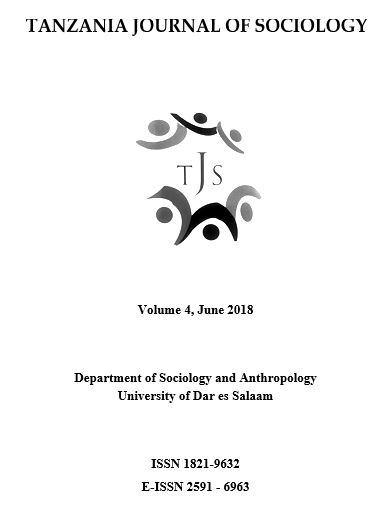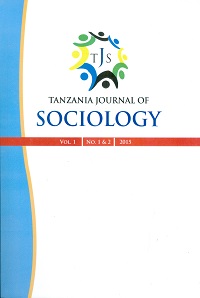Critiquing Experts ' Struggles to Amplify the Concept of ' Nutrition ' among Under-five Children in Southern Coastal Tanzania
Abstract
This article analyses experts ' views of the underlying causes of (under)nutrition issues among children in southern coastal Tanzania by paying attention to the sectors of agriculture, wildlife and fisheries. This critique is in the light of Harvey ' s (2003) concept of ' accumulation by dispossession ' and Foucault ' s (1976) concept of ' biopolitics ' . While accumulation by dispossession describes transformations that ensure the coexistence of commodity and non-commodity relations in southern coastal Tanzania, biopolitics highlights experts ' techniques with which both, the said relations and experts ' views of nutrition, are legitimized and reproduced. Using critical ethnography, we conducted in-depth interviews (IDIs) with experts at various levels and reviewed documents to highlight the techniques with which experts represent and legitimize their understanding of nutrition. Findings show that, despite struggles to amplify it, the experts ' view of nutrition remains exclusionist, representing coastal communities as isolated and restrictive to rational nutrition thoughts, actions and practices. In particular, the experts ' understanding of nutrition misses critical aspects, namely features of coastal communities such as production and consumption patterns as well as their views of nutrition for children. Accordingly, this paper recommends that experts should refashion their conceptual tools to enable them to capture the social organization, consequent social conditions of the coastal communities, and their experiences. All these play a critical role in shaping their understanding of ' nutrition ' among children in southern coastal Tanzania.
Key words: Experts, nutrition, undernutrition, accumulation by dispossession, biopolitics, social organization, social conditions, coastal people, southern coastal Tanzania
References
Amin, S. (2009). Eurocentrism: Modernity, region and democracy. A critique of Eurocentrism and democracy. New York: Monthly Review Press.
Caulfield, L., de Onis, M., Blossner, M., and Black, E. (2004) Nutrition as an underlying cause of child deaths associated with diarrhea, pneumonia, malaria and measles. Journal of Clinical Nutrition, 19 May, atajcn.nutrition.org.
Denzin, N.K & Lincoln, Y.S (Eds) (2000) Handbook of qualitative research. 2nd edition. Thousand Oaks: Sage.
Draper, M., Spierenburg, M., and Wels, H. (2007). Images of Africa: Agency and nature conservation in South Africa. In De Bruijn e al (Eds). Strength beyond structure: Social and historical trajectories of agency in Africa, 15-39. Boston: Brill.
Ferreira, F. R., Prado, S. D., Carvalho, M. C., Kraemer, F. B., (2015) "Biopower and biopolitics in the field of food and nutrition". In Rev. Nutr. [online]. 2015, vol.28, n.1,pp.109-119. ISSN 1415-5273. Available: http://dx.doi.org/10.1590/1415-52732015000100010.
Foucault, M. (1976). The history of sexuality: An introduction (Vol. 1). New York: Pantheon Books.
McIntosh, W.A. (1996). Sociologies of food and nutrition. New York and London: Texas A&M University.
Good, B. (1994). Medicine, rationality and experience: An anthropological perspective. Cambridge: Cambridge University Press.
Harvey, D. (2003). A brief history of neoliberalism. Oxford: Oxford University Press.
Harvey, D. (2006) Neo-liberalism as creative destruction. Swedish Society for Anthropology and Geography Geogr. Ann., 88 B (2): 145 €“158.
Hesse-Biber, S.N. (2007). The cult of thinness (2nd Ed.), Oxford: Oxford University Press.
Johansson, T. (2008). Beasts on fields: Human-wildlife conflicts in nature-culture borderlands. A case of village communities in Liwale, Tanzania. (Master ' s Dissertation, University of Helsinki, Finland, 2008).
Hyden, G (1980) Beyond Ujamaa in Tanzania: Underdevelopment and an uncaptured peasantry. Berkeley: University of California Press. Available: journals.sagepub.com/doi/abs/10.1177/000271628145700122
Kleinman, A. (1995). Writing at the margin: Discourse between anthropology and medicine. Berkeley: University of California Press.
Lupton, D. (1996). Food, the body and self. London and California: Sage Publication.
Madison, D. S (2004) Chapter 1: Introduction to critical ethnography: Theory and method. In Critical Ethnography: Method, Ethics, and Performance. Northwestern University USA: SAGE Publication. Available: http://dx.doi.org/10.4135/9781452233826.n1.
Matungwa, D. (2012). Poverty amidst plenty: Institutions and the social construction of scarcity in the use and benefit from marine fisheries resources: A case study of Kisiju Pwani Village, Mkuranga District, Tanzania (Master ' s Dissertation. University of Dar es Salaam, 2012).
Mukono, D. (2018). REDD+ Governmentality and social livelihoods discourses in Tanzania: Reflections from forest dependent communities in Lindi District (PhD Thesis Manuscript. University of Dar es Salaam, 2008).
Mwaipopo, R. (2001) The power of meaning: People and the utilization and management of coastal resources in Saadani village, Tanzania. (Doctoral Thesis, University of Cape Town, 2001).
Mwangome, M., Prentice, N., Plugge, E., & Nweneka, C. (2010). Determinants of appropriate child health and nutrition practices among women in rural Gambia. Journal of Health, Population and Nutrition, 28(2), 167-172.
Nally, D. (2010). The biopolitics of food provisioning. Transactions of the Institute of British Geographers, 36 (1), 37-53. Available: https://onlinelibrary.wiley.com/doi/abs/10.1111/j.1475-5661.2010.00413.x.
National Bureau of Statistics (NBS) [Tanzania] and ICF Macro. 2011. Tanzania demographic and health survey 2010 report. Dar es Salaam, Tanzania: NBS and ICF Macro.
Schooling, M (Ed.). (2015) Bourdieu ' s cultural capital in relation to food choices: A systematic review of cultural capital indicators and an empirical proof of concept. Plos One [Online serial], 10(8): e0130695. Available: doi: 10.1371/journal.pone.0130695. Accessed: January 8, 2018.
Sigalla, H. (2013) Trade-offs between wildlife conservation and local livelihood: Evidence form Tanzania. African Review, Vol. 40 (1). Available: http://journals.udsm.ac.tz/index.php/ar/article/view/185. Accessed: May 15, 2018.
UNICEF (2015) UNICEF 2015 annual report, 2015. Dar es Salaam, Tanzania: UNICEF
URT (1998) Wildlife Management Policy. Dar es Salaam: Government Publisher
URT (2005) Tanzania demographic and health survey 2004-2005 report. Available: https://dhsprogram.com/pubs/pdf/FR173/FR173-TZ04-05.pdf. Dar es Salaam, Tanzania: National Bureau of Statistics.
URT (2009) Wildlife Conservation Act. Dar es Salaam: Government Publisher.
URT (2010) Tanzania demographic and health survey 2010 report. Available: http://www.nbs.go.tz/nbs/takwimu/references/2010TDHS.pdf. Dar es Salaam, Tanzania: National Bureau of Statistics.
URT (2014) Tanzania national nutrition survey 2014. Final report. Dar es Salaam, Tanzania: Tanzania Food and Nutrition Centre.
URT (2016) Tanzania demographic and health survey and malaria indicator survey 2015-16. Final Report. Available: https://dhsprogram.com/pubs/pdf/fr321/fr321.pdf. Dar es Salaam, Tanzania: National Bureau of Statistics.



